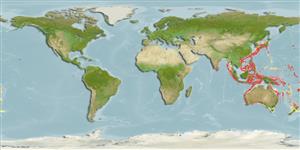Environment: milieu / climate zone / depth range / distribution range
Ecologia
marino batidemersale; distribuzione batimetrica 140 - 600 m (Ref. 44036). Deep-water
Western Pacific: southern Japan. More recent works report of its occurrence in Taiwan (Ref. 5193), Malaysia (Ref. 5756) and the Chesterfield Islands (Ref. 11897).
Size / Peso / Age
Maturity: Lm ? range ? - ? cm
Max length : 95.0 cm SL maschio/sesso non determinato; (Ref. 559); common length : 35.0 cm NG maschio/sesso non determinato; (Ref. 27550)
Short description
Chiavi di identificazione | Morfologia | Morfometria
Spine dorsali (totale) : 0; Raggi dorsali molli (totale) : 8 - 10; Spine anali: 0. Longest ray of pelvic fin thin, long reaching to or near tip of pectoral fin. Lip of upper jaw thin. Upper jaw with a short band of villiform teeth; lower jaw, palatine, pre vomer and tongue toothless. Body purplish-brown, semi-transparent. Attain 95 cm SL.
Feeds on prawns (Ref. 27550).
Life cycle and mating behavior
Maturità | Riproduzione | Deposizione | Uova | Fecundity | Larve
Masuda, H., K. Amaoka, C. Araga, T. Uyeno and T. Yoshino, 1984. The fishes of the Japanese Archipelago. Vol. 1. Tokai University Press, Tokyo, Japan. 437 p. (text). (Ref. 559)
IUCN Red List Status (Ref. 130435: Version 2024-1)
Threat to humans
Harmless
Human uses
Pesca: di nessun interesse
Strumenti
Special reports
Download XML
Fonti Internet
Estimates based on models
Preferred temperature (Ref.
123201): 8.1 - 18.9, mean 13.1 °C (based on 271 cells).
Phylogenetic diversity index (Ref.
82804): PD
50 = 0.5315 [Uniqueness, from 0.5 = low to 2.0 = high].
Bayesian length-weight: a=0.00389 (0.00180 - 0.00842), b=3.12 (2.94 - 3.30), in cm total length, based on all LWR estimates for this body shape (Ref.
93245).
Trophic level (Ref.
69278): 4.2 ±0.73 se; based on food items.
Fishing Vulnerability (Ref.
59153): High to very high vulnerability (70 of 100).
